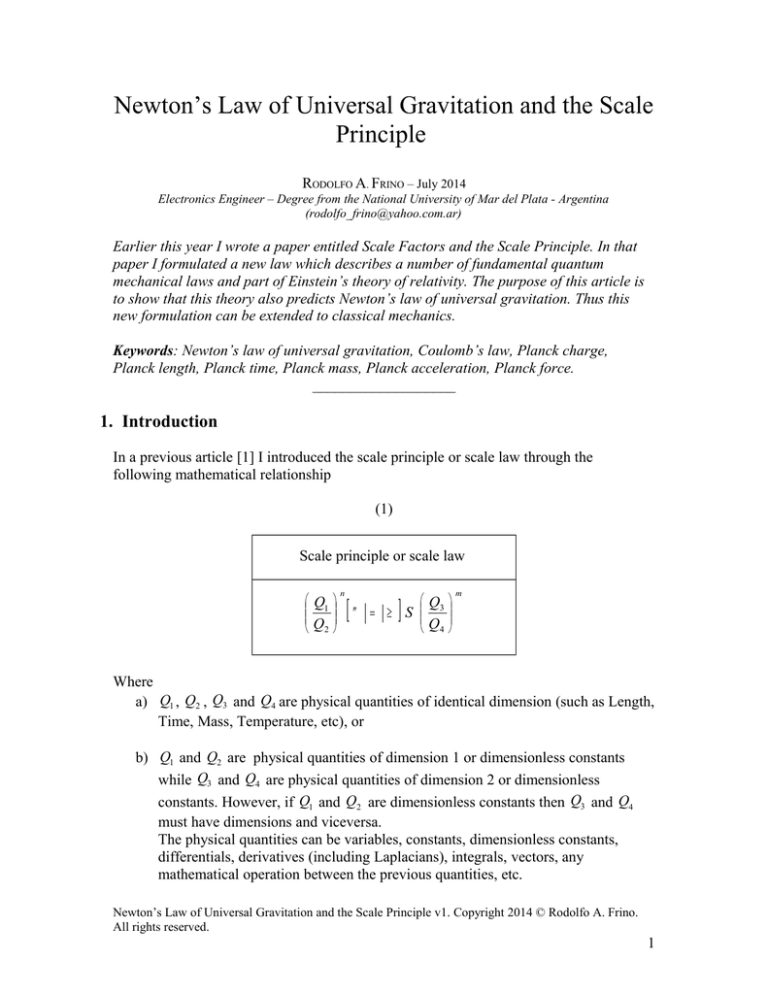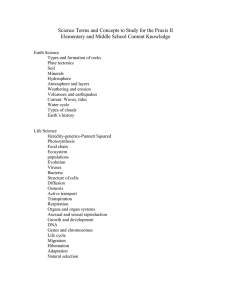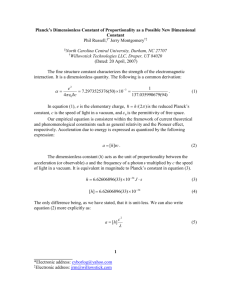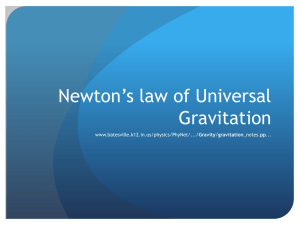
Newton’s Law of Universal Gravitation and the Scale
Principle
RODOLFO A. FRINO – July 2014
Electronics Engineer – Degree from the National University of Mar del Plata - Argentina
(rodolfo_frino@yahoo.com.ar)
Earlier this year I wrote a paper entitled Scale Factors and the Scale Principle. In that
paper I formulated a new law which describes a number of fundamental quantum
mechanical laws and part of Einstein’s theory of relativity. The purpose of this article is
to show that this theory also predicts Newton’s law of universal gravitation. Thus this
new formulation can be extended to classical mechanics.
Keywords: Newton’s law of universal gravitation, Coulomb’s law, Planck charge,
Planck length, Planck time, Planck mass, Planck acceleration, Planck force.
___________________
1. Introduction
In a previous article [1] I introduced the scale principle or scale law through the
following mathematical relationship
(1)
Scale principle or scale law
Q1
Q
2
n
[
]
Q
≤ = ≥ S 3
Q4
m
Where
a) Q1 , Q2 , Q3 and Q4 are physical quantities of identical dimension (such as Length,
Time, Mass, Temperature, etc), or
b) Q1 and Q2 are physical quantities of dimension 1 or dimensionless constants
while Q3 and Q4 are physical quantities of dimension 2 or dimensionless
constants. However, if Q1 and Q2 are dimensionless constants then Q3 and Q4
must have dimensions and viceversa.
The physical quantities can be variables, constants, dimensionless constants,
differentials, derivatives (including Laplacians), integrals, vectors, any
mathematical operation between the previous quantities, etc.
Newton’s Law of Universal Gravitation and the Scale Principle v1. Copyright 2014 © Rodolfo A. Frino.
All rights reserved.
1
(e.g.: Q1 and Q2 could be quantities of Mass while Q3 and Q4 could be quantities
of Length).
c) The relationship is one of three possibilities: less than or equal to inequation ( ≤
), or equal to - equation (=), or a greater than or equal to inequation ( ≥ ).
d) S is a dimensionless scale factor. This factor could be a real number, a complex
number, a real function or a complex function (strictly speaking real numbers are
a particular case of complex numbers). The scale factor could have more than one
value for the same relationship. In other words a scale factor can be a quantum
number.
e) n and m are integers 0, 1, 2, 3,… (In general these two numbers are different.
e.g. 1: n =1 and m = 1. e.g. 2: n = 1 and m = 2. n and m cannot be both zero in the
same relationship). It is worthy to remark that so far these integers are not greater
than 2, however this could change in the future.
2. The Planck Force
In this section I shall derive the Planck force from two known laws. In subsection 2.1 I
start the analysis from the Coulomb’s law while in subsection 2.1 the starting point is
Newton’s second law of motion. The results of these two independent derivations are
identical as it should be. The Planck force is used in section 3 to derive the law of
universal gravitation.
2.1 Derivation of the Planck Force based on Coulomb’s Law
We shall derive the Planck force from Coulomb’s law
FE =
1 q1q2
4π ε 0 r 2
(Coulomb’s law)
(2)
We shall substitute both charges q1 and q2 with the Planck charge QP and the distance r
with the Planck length LP , this yields
FP =
Q P2
(3)
L2P
Where
QP ≡
2ε 0 h c
(Planck charge)
(4)
Newton’s Law of Universal Gravitation and the Scale Principle v1. Copyright 2014 © Rodolfo A. Frino.
All rights reserved.
2
hG
2π c 3
LP ≡
(Planck length)
1 2ε 0 h c
FP =
4π ε 0 h G
2π c 3
(5)
(6)
Finally the Planck force is
c4
G
FP =
(Planck Force)
(7)
2.2 Derivation of The Planck Force based on Newton’s Second Law of
Motion
We shall derive the Planck force from Newton’s second law of motion
F = ma
(8)
The Planck force can also be defined as
FP ≡ M P a P
(9)
Where
FP = Planck force
M P = Planck mass
a P = Planck acceleration
The Planck mass is defined as
MP ≡
hc
2π G
(10)
The Planck acceleration can be defined as
aP≡
c
TP
(11)
Newton’s Law of Universal Gravitation and the Scale Principle v1. Copyright 2014 © Rodolfo A. Frino.
All rights reserved.
3
Where
c = speed of light in vacuum
T P = Planck time
hG
2π c 5
T P≡
(12)
Substituting T P in equation (11) by the second side of equation (12) yields
2π c 5
hG
aP= c
(13)
2π c 7
hG
aP=
(14)
Substituting M P and a P in equation (9) with the second side of equations (10) and (14)
respectively yields
h c 2π c 7
2π G hG
FP =
(15)
Finally the expression for the Planck force is
FP =
c4
G
(Planck Force)
(16)
3. Derivation of the Universal Law of Gravitation
In this section I shall derive Newton’s law of universal gravitation from the scale
principle. In 1687 Isaac Newton published his Principia where he stated his universal law
of gravitation as follows
FG = G
m1m2
r2
(Newton’s law of universal gravitation)
(17)
Where
FG = Gravitational force between two any bodies of masses m1 and m2 (this force is also
known as force of universal gravitation, gravity, gravity force, force of gravitational
attraction, force of gravity, Newtonian force of gravity, force of universal
mutual gravitation, etc.)
G = Gravitational constant (also known as constant of gravitation, constant of gravity,
Newton’s Law of Universal Gravitation and the Scale Principle v1. Copyright 2014 © Rodolfo A. Frino.
All rights reserved.
4
gravitational force constant, universal constant of gravity, universal gravitational
constant, Newtonian gravitational constant, etc.)
m1 = mass of body 1
m2 = mass of body 2
r = distance between the centers of body 1 and body 2
We start the analysis by observing that the numerator of equation (16) [or equation (7)] is
c 4 . This suggests that the equation we are looking for should originate from the product
of two relativistic energies such as E1 ≡ m1 c 2 and E2 ≡ m2 c 2 . We also notice that the c 4
factor of the product m1 m2 c 4 should cancel out with the numerator of equation (16).
Thus, taking into consideration these facts, we draw the following scale table
Work
WG
Work
Energy
Energy
(relativistic)
(relativistic)
E1
E2
W
TABLE 1: This scale table is used to derive Newton’s law of universal gravitation.
In summary, the quantities shown in Table 1 must be defined as follows
WG ≡ FG r
(Work done by FG )
(18)
W ≡ FP r
(Work done by FP )
(19)
E1 ≡ m1 c 2
(Relativistic energy of body 1)
(20)
E2 ≡ m2 c 2
(Relativistic energy of body 2)
(21)
From the table we establish the following relationship
WG W = S E1 E2
(22)
Replacing the variables WG ,W , E1 and E2 by equations (18), (19), (20) and (21)
respectively we get
FG r FP r = S m1 c 2 m2 c 2
(23)
G 1
m1 c 2 m2 c 2
4
2
c r
(24)
FG = S
Newton’s Law of Universal Gravitation and the Scale Principle v1. Copyright 2014 © Rodolfo A. Frino.
All rights reserved.
5
FG = S G
m1 m2
r2
(25)
If S = 1 we obtain the Newton’s law of universal gravitation (see equation 17).
Thus we have proved that Newton’s law of universal gravitation can be derived from the
scale principle. It is worthy to remark that the gravitational constant G is not the scale
factor as one might be tempted to think. Scale factors are dimensionless while the
gravitational constant is not.
Now let us express equation (23) in the form of the scale principle
FG r
m2 c 2
=
S
m1 c 2
FP r
(26)
Comparing equation (26) with equation (1) we find that equation (26) has the following
form
Q
Q1
=S 3
Q2
Q4
(27)
Where
n= m= 1
Q1 = FG r
Q2 = m1 c 2
Q3 = m2 c 2
Q4 = FP r
Thus we have proved that Newton’s law of universal gravitation obeys the scale
principle.
4. Conclusions
In this paper we have formulated a relativistic quantum mechanical derivation of the
Newton’s law of universal gravitation. The derivation is relativistic because we used the
total relativistic energy m1 c 2 and m2 c 2 of the attracting bodies. At the same time the
derivation is quantum mechanical because we introduced the Planck force ( c 4 G ).
However the law we obtained is a classical law.
Newton’s Law of Universal Gravitation and the Scale Principle v1. Copyright 2014 © Rodolfo A. Frino.
All rights reserved.
6
Taking into account that the scale law describes several known laws of physics as I have
shown both on previous papers [1, 2, 3, 4, 5] and on this paper, we can consider the scale
law as a more universal law than the specific laws it describes.
REFERENCES
[1] R. A. Frino, Scale Factors and the Scale Principle, viXra: 1405.0270, (2014).
[2] R. A. Frino, The Special Theory of Relativity and the Scale Principle, viXra:
1406.0144, (2014).
[3] R. A. Frino, The Schwarzchild Radius and the Scale Principle, viXra: 1406.0164,
(2014).
[4] R. A. Frino, The Fine Structure Constant and the Scale Principle, viXra: 1406.0169 ,
(2014).
[5] R. A. Frino, The Bohr Postulate, the De Broglie Condition and the Scale Principle,
viXra:, (2014).
Newton’s Law of Universal Gravitation and the Scale Principle v1. Copyright 2014 © Rodolfo A. Frino.
All rights reserved.
7







